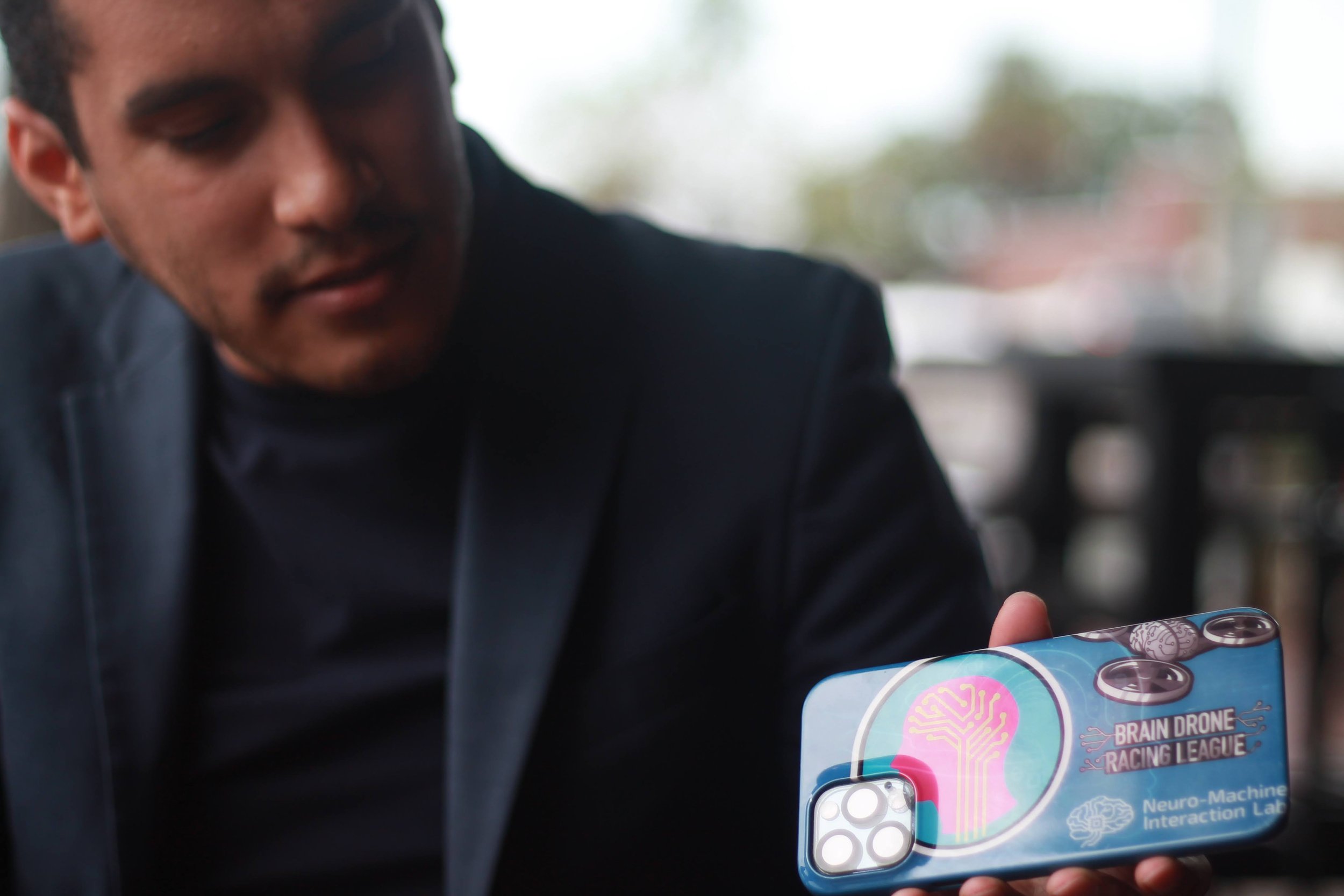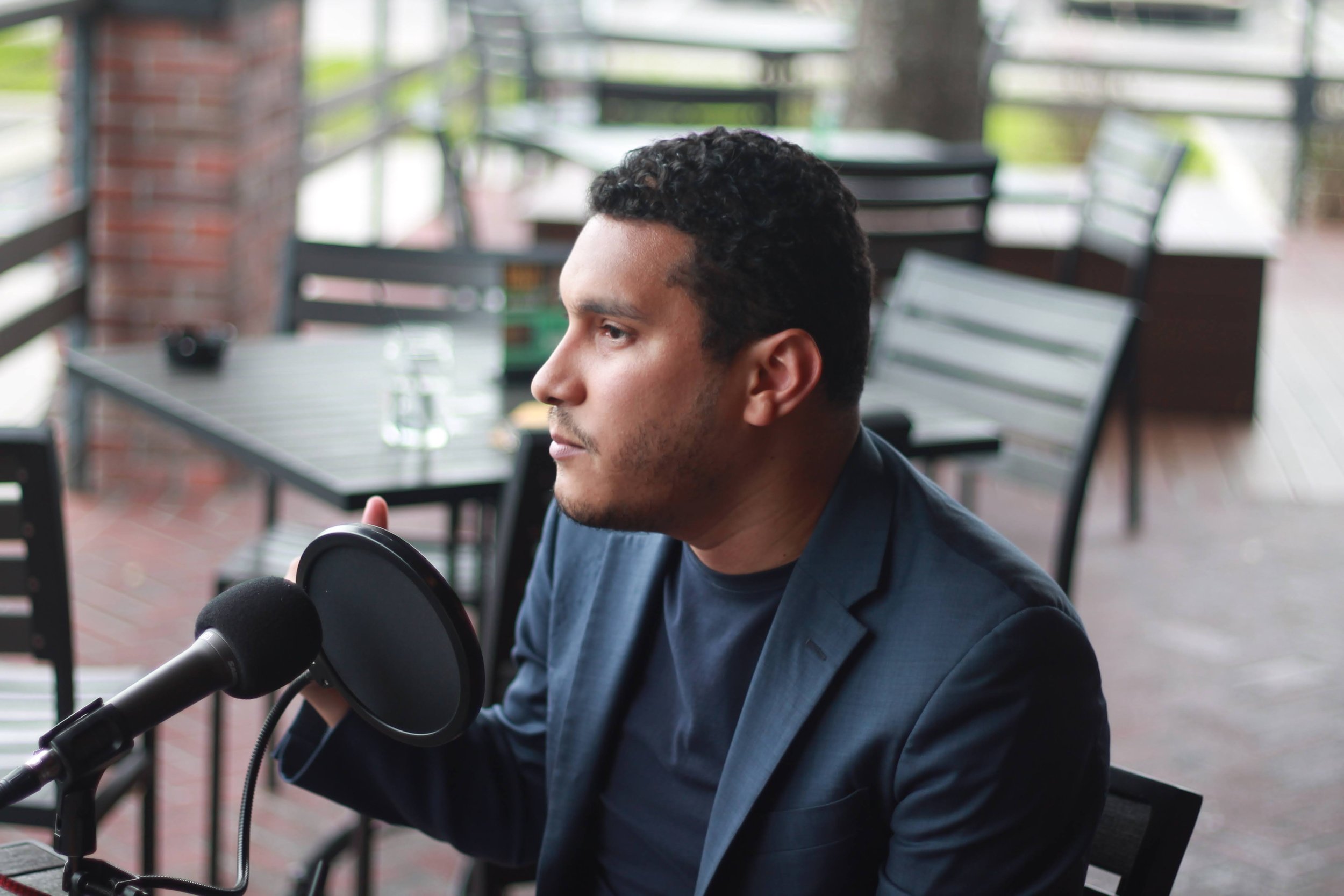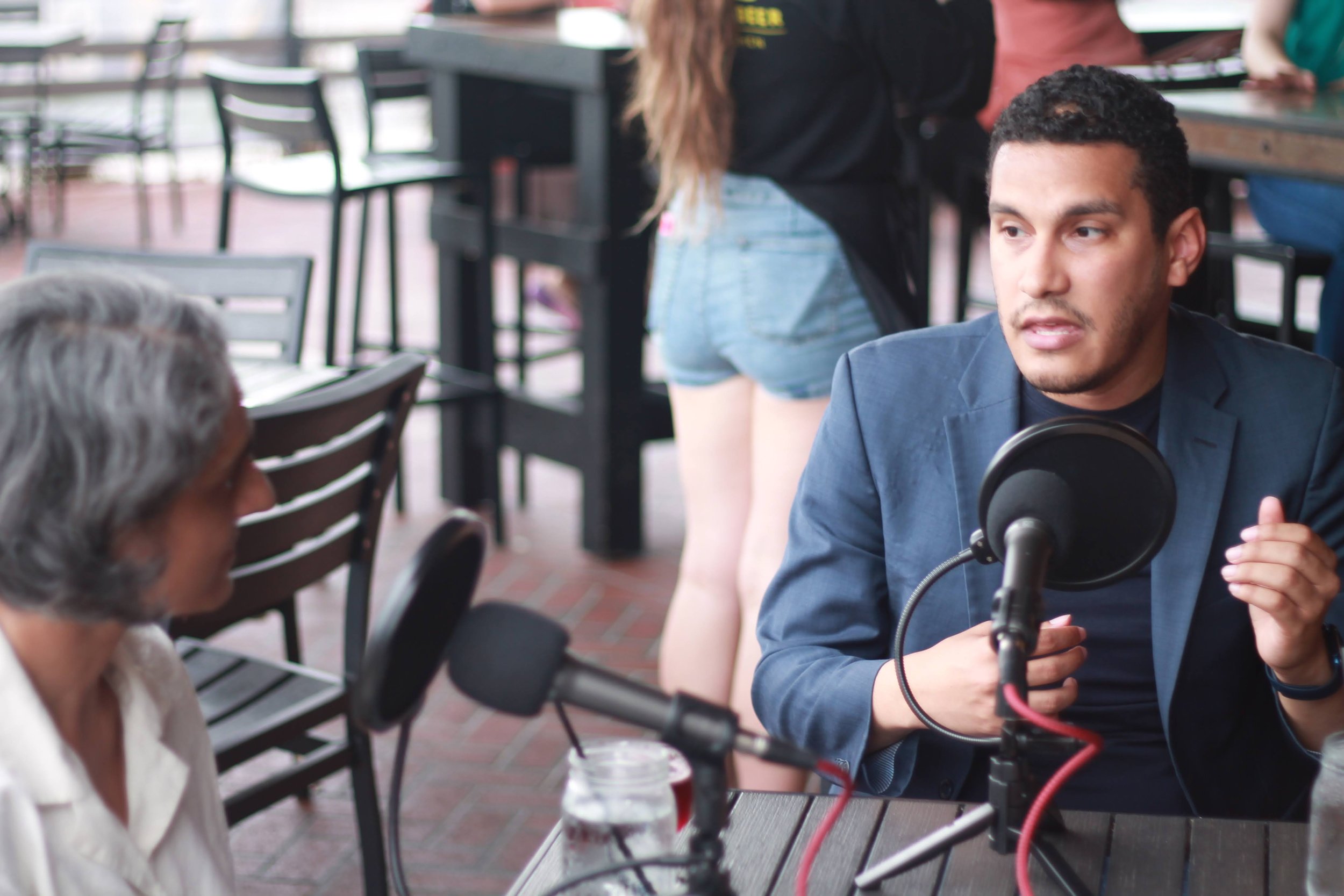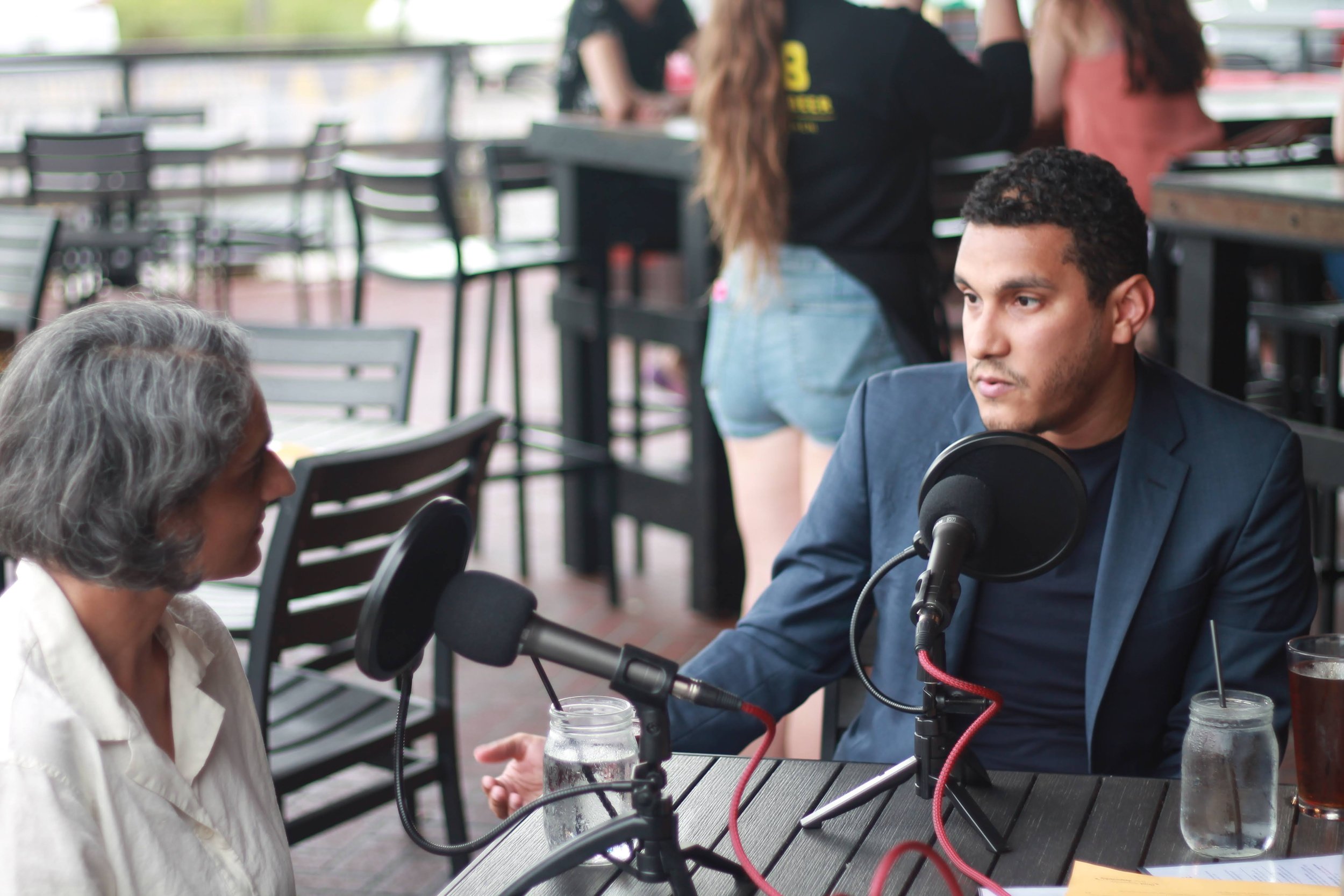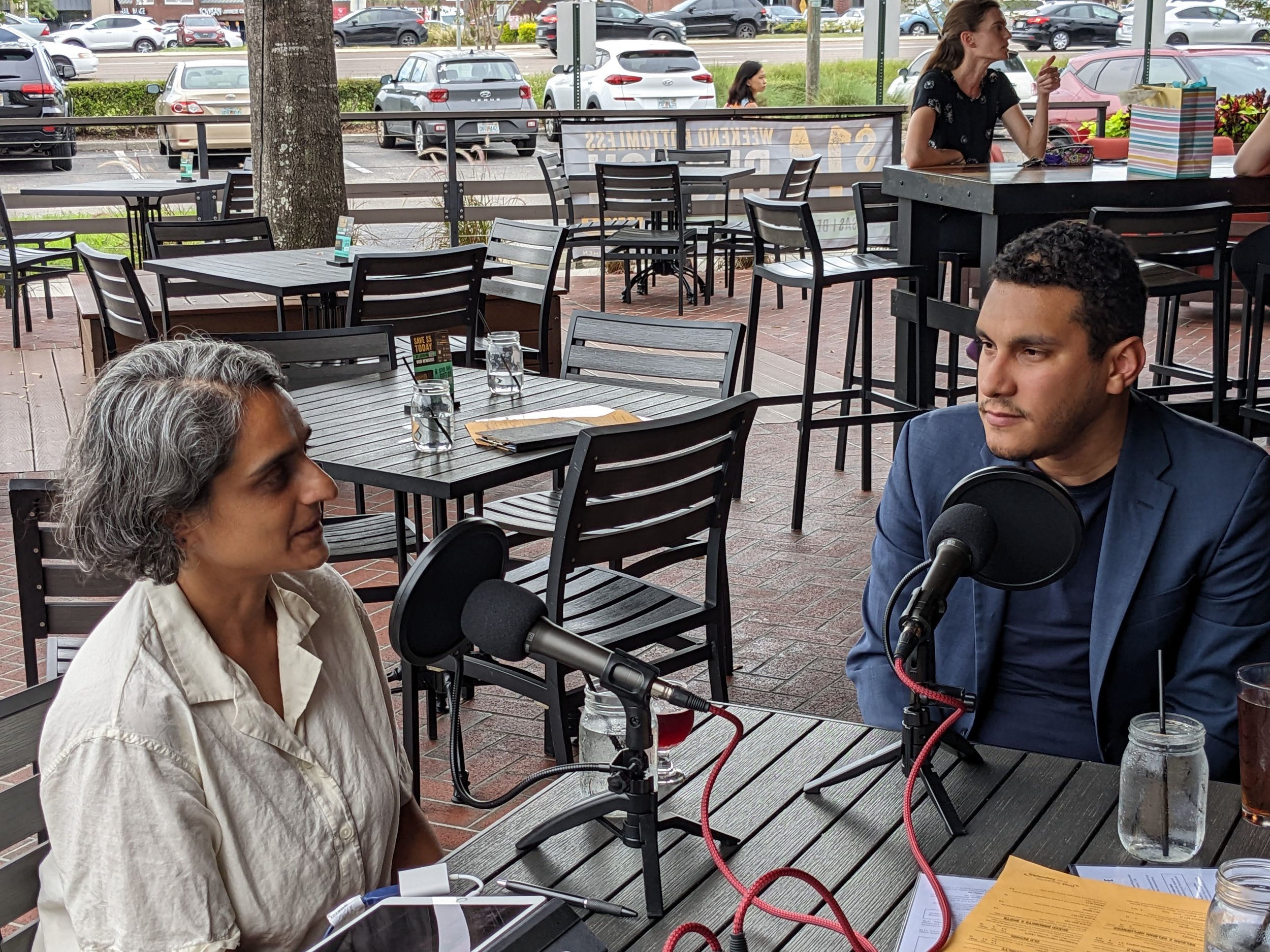Brains, drones and smart apps for our phones
Have you ever just though how easy it would be to control everything with your brain? Poof, the lights go on, and Netflix just chooses your favorite show. Beyond these niceties though, Dr. Marvin Andujar has bigger and better plans.
Working as a computer scientist at the University of South Florida, Marvin is developing brain-computer interfaces to do fun things like fly drones. But also with more practical applications like helping those with ADHD, dementia and anyone looking to improve their mental health.
Join us to learn more about what we can do with the power of our minds.
Check out Marvin’s work and interviews on his site: marvinandujar.com and follow him on: linkedin, twitter, or instagram.
As promised, you can find The Easy Button’s music on Bandcamp: theeasybutton.bandcamp.com along with all their socials.
Listen:
Watch:
Subscribe to our YouTube channel now for all future recordings.
Episode transcript
[Background intro music playing is "She doesn’t live there any more" by The Easy Button]
Parmvir: So welcome folks to another episode of 2Scientists, where inspiring scientists share their work with you wherever you like to listen. And today's guest is not only inspiring, but his work, at least to me, sounds so much like science fiction. Thank you for joining us, Dr. Marvin Andujar.
Marvin: Yeah, thank you for the invitation,
Parmvir: You are an assistant professor in the Department of Computer Science and Engineering, and there you are the director of something that's referred to as the Neuro Machine Interaction Lab. That sounds like potentially you have fingers in a lot of pies and that your background extends to a lot of different things.
Is that right?
Marvin: Yes. So, my background is on computer science, so my bachelor's was in computer science and mathematics, and my PhD specifically on human center computing, which is a combination of psychology and computer science and other fields. So, I was always interested about the human brain.
Parmvir: Yeah.
Marvin: Hated biology to be honest [laughs] . So I just, I was like this is not for me. But then I love technology.
Parmvir: Yeah.
Marvin: And I love math. So when I heard the field of brain-computer interfaces, that of course in the medical field brain-computer interfaces, has been around for a while.
Parmvir: Mm-hmm.
Marvin: Then I was extending to non-medical work in the early two thousands, and when I was an undergrad I heard about it and I was like this is what I really want to do.
Parmvir: Yeah.
Marvin: So, yeah.
Parmvir: It's, I mean, it sounds incredibly cool from the get-go, but I wanted to say back to the very beginning, I saw a lovely interview with you in like the Tampa magazines, which mentions that you're from Santa Domingo in the Dominican Republic.
Marvin: Yep.
Parmvir: And your parents were your inspiration.
Marvin: Mm-hmm.
Parmvir: So how was it that you ended up in the US and doing engineering?
Marvin: Yes. So, my parents decided to move to the states, when I was a freshman in high school. They thought it was the best move for us as a family. So, of course the whole green card application to be able to work here in the States. And then when I got to the States, I was a sophomore in high school. Of course, I didn't know English, so I had to learn English and learn a brand new system. Then applied for colleges a few years later. But then in my final year of high school, I was wondering what would be my major.
I knew I loved computer science. Well, I love computers. I didn't know what computer science was. And someone said, oh, you should do IT, you should do information technology. If you like computers, you like, you know, playing around with technology. So my major was IT when I applied for colleges.
Then I take my first computer science class, and in my mind I thought computer science was Microsoft Office, doing PowerPoint Excel. Until I see my professor writing code on the board. I was like, I have no idea. What is she talking about? Even after that first lecture, I had a big headache.
I was like, this is completely different from what I expected. And the funny thing is, that's typical. People really think that computer science is all fixing computers and you know, Microsoft Office and it's really not, right? We never fix a computer in any of our classes, right? So even my family think that, that's partially what I do. But yes, so that's how I started doing engineering.
I still love computer science. Even then, even when I learned more about it. And then through time I started doing research as an undergrad. I did research for about five years as an undergrad when I was doing double major. And I fell in love with research that I decided to pursue a PhD and that's why I'm doing engineering still.
Parmvir: Okay. Yeah. So funnily enough, between David and myself, it feels like a mashup of our two backgrounds. So, I'm a neuroscientist and he is a computer scientist.
Marvin: Oh, nice. Okay.
Parmvir: Yeah. So I'm sure he'll have some probing questions for you at some point during the interview,
But kind of going back to your lab and the group that you started, I guess the first thing I want to know is what is the history of these kinds of brain-machine interfaces? So for something like prosthetics and creating new limbs and kind of being robot humans, I can see that as a natural progression, right.
Marvin: Right.
Parmvir: But when it comes to the idea that you are going to use electrical activity in the brain to power something that's somewhere else.
Marvin: Mm-hmm.
Parmvir: How did that come about? And essentially what is it that you do in your research?
Marvin: Yes. So even back in the sixties, fifties, there was a lot of work done with electrical signals using EEG sensors to be able to get electrical signals from the brain for different purposes. We saw that of course, in psychology and in understanding more in neuroscience, right? So using EEG's and also MRI machines.
But the term brain computer interfaces didn't exist until the 1970s. And the idea behind it was to use our brain activity actively. So if I'm imagining a movement in my head, can we associate that with a task. Meaning that, can I open a door with my brain?
Parmvir: Mm-hmm.
Marvin: And that started more instead of just collecting data and saving it for analysis purposes and for other great things, then it's how can we use that for applications?
Parmvir: Yeah.
Marvin: So neuroprosthetics, people in a wheelchair, can they move the wheelchair with the brains?
Thankfully with the findings from neuroscience and currently psychology, we have learned enough about the human brain, then the computer scientist said: well, I think we know enough now to be able to do a lot of work outside medicine. Or help them also through machine learning, signal processing to be able to get better signals from the brain, with our devices.
So, the work that we started, at least when I started doing brain-computer interfaces in the early two thousands, I was an undergrad. I was doing a summer program for undergrads at Clemson University. And, at the time he was just my RU advisor, then he became my PhD advisor later on. And then he shared that idea with us before we got to the lab that summer and said, well bring the interfaces.
And I asked, what is that? And he said, well, we're trying to combine the human brain with technology. I was like, this is it. [Both laugh] This might be my field. And then when I got there in the summer, they're like, well, we're, we're about to start this here. Brain-computer interfaces. So I started working with one of the PhD students. Now he's a principal engineer at Intel on the West coast.
And then we started coming up with ideas and say, well, we don't want to do neuroprosthetics, we don't want to do wheelchair, because that's more in biomedical engineering. We are computer scientists, so we need to come up with our own ideas that outside of it.
So we started looking into how can we use BCI's (Brain-computer interfaces) for education purposes. Then the Brain-Computer Interface Society just a few years back created a roadmap, on where do we want to see brain-computer interfaces in the year 2025.
And one of them was, can we use BCI's for education? And the idea is like, can we track engagement of students, count their workload using EEG, right. Using brain-computer interfaces. And they provide feedback to those students so they can have a better learning experience.
So that's what we came up with. We did some work on that. And then of course, once I became a PhD student, I met my colleague called Chris Crawford. He's an assistant professor at University of Alabama right now. So we did our PhDs together.
Parmvir: Yeah.
Marvin: And when we started, the great thing about it was that my PhD advisor allowed us to work on any project that we wanted because it was an open field at the time. And then I asked my colleague and said: Hey, what are you working on right now? He's like, oh, not much, our advisor has me working on this project, whatever. And then I said, oh, we should work on brain-controlled drones.
Parmvir: Mm-hmm.
Marvin: And he looked at me like I was drinking something [both laugh]
It's like, Marvin must be drunk right now. I was like yeah brain-controlled drones. The reason why I brought it up, it was because he was working on drones before and I also was already working on brain-computer interfaces. So I wanted to combine both of them. So that's how our work on brain-controlled drones, brain-drone racing, came along.
And we did a Brain-drone race back in 2016, and of course we did one here at USF back in 2019, if I'm not mistaken. So yeah, that's working on some of the things I'm working on now.
Parmvir: So expanding on the brain drone racing. You have a very nice little TEDx talk that you gave a while back, which we'll link to in our show notes. But it starts off as a fairly standard, like we are doing some cool things with tech, but it actually becomes a much more profound conversation about how we can use or utilize these things to help people with disabilities and level the playing field. Can you actually tell us more about this specific race and what it is that you think that it achieves.
Marvin: Yes. So once we had a prototype on the brain control drone technology, which we started back at Clemson University. And then my advisor moved, so we moved with him we moved to University of Florida. So we, we're just sitting in the lab and we started thinking, what's next?
So we have a brain-controlled drone. I mean, we can always do the computational aspect, make it more accurate, but we wanted to do something more than just that. So we came up with the idea of brain-drone racing.
Drone racing in general. It started to take off.
Parmvir: Right.
Marvin: That was back in 2015, 2016. And then we were thinking, how about if we do something similar to like brain-drone racing? And the whole goal of that brain drone racing was to educate society or that brain-computer interfaces exist, and that it's not science fiction.
Parmvir: Yep.
Marvin: Right. So even still today, people say, when I tell them the stuff I work on, they're like, wait, so are you talking about the movies?
Parmvir: Yeah.
Marvin: Stranger things. Star Wars.
I'm like, no, this is real. Even when I show videos to some people, they still don't believe it.
Parmvir: Yeah.
Marvin: They're like, oh, you know, we can always fake videos and tech. No, this is real stuff.
So that's why that was the main goal of it.
Parmvir: Yeah.
Marvin: So I would say a few days before the race the associated press wanted to cover the race. And they sent us an email saying, It was like about a good paragraph telling us like, well, we want to be honest. That's what AP told us: we don't believe this is real. This is like 48 hours before the race.
Parmvir: Right [laughs]
Marvin: Yeah. It was like, we don't believe this is real. We talked to our editor and he said he's skeptical. We emailed MIT and Harvard and whoever, and although they say that it's possible, we're still skeptical. They saw a video that was covered by Fox News at the time. They still didn't believe in the video.
Parmvir: Uhhuh.
Marvin: So I was like, how can I convince the associated press to travel to Florida to cover this race?
And I pretty much told them, well, look, the only way you are able to see if this is real is by coming here. And try it yourself.
Parmvir: Yeah.
Marvin: Right. Every new technology people always are gonna be skeptical.
Parmvir: Yeah.
Marvin: People were skeptical about planes. The fact that you put hundreds of people, in a flying submarine, to go from one country to the other.
Parmvir: Yeah.
Marvin: So, and that's exactly what I said in the email. I said, look at us now. We use planes every single day. And he pretty much said: see you on Saturday.
Parmvir: Okay.
Marvin: Yeah. So, and they, of course they covered the race. They tried it, they saw that it was real. We had students racing and after the coverage from the news, which was covered by Discovery Channel in New York Times, the response that we got from society about it, that's when we saw that regardless of gender, your physical abilities and disabilities, you can compete in the same sport.
Parmvir: Yeah.
Marvin: That's when we are like, wait a second, this one can be the one that is the most inclusive sport.
Parmvir: Yeah.
Marvin: Because only your brain is needed. Right, so I could be 50 years old and compete against somebody who's 20, 30 years old as long as I'm keeping my mind in shape. And again they don't have to worry about someone being taller or stronger. It's all about your capabilities of concentrating for a long period of time.
Parmvir: Yeah.
Marvin: And that's when we started thinking we may have something here that we can provide to people that is more inclusive than what we have right now in society. So that's why we started doing more races. My colleague at University of Alabama did his own race and we did of course one here at USF.
And we hope to do more races in the future and make it more applyable at different universities.
Parmvir: It does sound very exciting. I'd love to come and see it. So. David hates sharing stuff on the microphone.
Marvin: Okay.
Parmvir: I forced him to start doing the interviews in Spanish, but other than that [Marvin laughs] , so he asked questions via a messenger.
So he said, if your life depended on it, is there anything you would still trust a human to do with a regular interface that you wouldn't with a neural one?
Marvin: That's a great question.
As of right now, I wouldn't depend on brain-control much, depending on the person, right? So, not myself, but other people at least, had people driving a Formula One car with their brains. I definitely will not get in a car, and [Parmvir laughs] they tell me they're about to brain [Marvin laughs] brain-control their car.
I think I would prefer autonomous at that point.
Parmvir: Yeah.
Marvin: Controlling in video games, definitely I'd trust it. Right, so simulations virtual reality. Of course the brain-controlled drones are great as long as in a safe space.
Parmvir: Yeah And presumably for each one of these things, like in order to be able to use it in real life, people would have to train up.
Marvin: Yes. That's a great point. People always ask me, even in my classes, it doesn't take long to train or to get used to it. It really depends on the person.
Parmvir: Right.
Marvin: So I always use the example of athletes. Some of them are natural and some of us really need to train for a long period of time to be able to catch up to that.
Who is a natural.
Parmvir: Or, some of us will never get to that point. [both laugh] .
Marvin: But when it comes to brain activity, we can, right?
Parmvir: That's true.
Marvin: So it takes a few seconds, a few minutes to be able to train, but then it takes days, weeks for mastery.
Parmvir: Right.
Marvin: And of course our technology still needs to improve for us to be able to do things that is more real time.
Parmvir: Right.
Marvin: The second part of it, we are asking people to use their brains in a way they had never used it before.
So when we walk, we don't think, oh, I need to walk.
Parmvir: Yep.
Marvin: We just walk. In this case, I'm actually telling people, imagine yourself walking to be able to generate that brain activity so you can control this drone. It's a completely different way.
Parmvir: Yeah.
Marvin: Kids, they're great at doing these things right, because they're still, you know, they're more creative.
They're no adults. Adults, they take longer time to be more creative with those thoughts.
Parmvir: We're talking a lot about, how you actually use these things, how you implement them, but can we backtrack a little bit and exactly what does this thing look like?
How does it work on a very practical level? How is it that a brainwave or something happening in your brain can then be translated into a physical thing happening over there?
Marvin: Each part of our brain have their own functions. That's all thanks to neuroscience and current psychology that they have studied and find out what are the functions of each part of the brain. So we try to grab those electrical signals using what we call neurotechnology headsets nowadays. Neurotechnology is typically any headset that we're able to get brain data information from people.
Parmvir: Yep.
Marvin: It could be either non-invasive, meaning that it's just on top of their head, or invasive meaning that it will require surgery.
Parmvir: Okay.
Marvin: In that case, so the work that I do is mainly, of course, non-invasive. We get electrical signals from the brain. Of course we have to clean up that signal from any noise, any unwanted data, like muscle movement, eye blinks, we clean up all that. We're using algorithms and then using what we call machine learning algorithms to be able to classify those signals into that particular task. In general, that's how we're able to get those electrical signals from the brain and classify them to a specific application.
So an example I can give you that I always use is when you are driving and we are able to detect if you're falling asleep.
Parmvir: Yeah.
Marvin: So it is, we have something called theta. We all have that theta wave in our brain activity. So it's more related to drowsiness, right before you fall asleep, which is your delta stage. So if you're driving and you're wearing a brain-computer interface what we know as a neurotechnology, as soon as we detect your, mainly that theta stage, then your car probably can give you a notification saying you may want to pull over, you're about to go to sleep.
Parmvir: Yeah.
Marvin: Or in this case, if you are driving in a smart car like Teslas or another electric car, then they will start the autopilot right before you sleep, and then park for you, at a safe space.
Parmvir: Yeah.
Marvin: So that's the idea of how we can use these type of technologies and how it will work in practicality.
Parmvir: So I mean, looking at your webpage and the kind of the various things that you do research on, there's a lot under there. But one of the other practical things that I noticed that came up, a specific example is ADHD and helping people improve concentration.
Marvin: Yep.
Parmvir: So how does that work? Because as you mentioned with a theta wave, you, you have something very specific you're measuring.
Marvin: Yep.
Parmvir: How do you measure something like concentration and use that in people with ADHD?
Marvin: Yes. So, in that case we look into what we call beta waves. So it's more related to alertness, and concentration.
Of course we look more into other waves as well. And we use what we call an engagement formula. But we look into alertness and try to remove drowsiness and relaxation from the attention data. So the idea of improving attention for those with ADHD came about because of the community.
So every time I did a demo with brain-controlled drones, or the simulation that we have, adults will just come to me and ask me: How they can buy the technology because they would like to use it at a home, to train their attention because they have ADHD.
Parmvir: Yep.
Marvin: And then when I have some presentations. And I have mentioned like, oh, this may be useful to train your attention, I get someone in the audience with ADHD saying, I wouldn't want to use drugs, I want to use this.
Parmvir: Yep.
Marvin: So the community pretty much told me, you need to start working on this [both laugh].
They're like: just help us out.
Parmvir: Yeah.
Marvin: And that's when we started looking into brain art, what we call brain painting.
Parmvir: Okay.
Marvin: To be able to create your own, abstract paintings with your brain, where you're concentrating a stimulus, so it'll be, you're considering different objects and colors in the screen, and then you can create your own art. The reason why we decided that method to be able to improve attention is because you had to concentrate for a long period of time.
So if I try to brain paint, create my paintings with my brain and my phone rings, then as I pick up my phone, I get distracted. So I'll be selecting the wrong object or the wrong color. Or the system will not be able to select anything at all. So now I have to go back to it to concentrate on what I was trying to select.
So that mental discipline is, it can be trained. And then the number two part of it is doing the brain painting in a virtual reality environment. The reason why we decided that, is when you're more immersed in your own painting and we're trying to find out if we can improve your mental health.
As art is related to improved health, mental health in that sense, being inside your own painting, you'll be less distracted, because you'll be more immersed in the painting and the activity that you are doing.
Parmvir: Yeah.
Marvin: So that's why we're collecting data right now, with participants and we're trying to hopefully see some improvement there over time.
Parmvir: I have to say it feels like it, it must be really nice to have a very tangible impact of your research on people. And related to that, and actually this is one I was thinking of as well, so David says, your work seems to be at the intersection of many disciplines. Who do you work and collaborate with?
Marvin: That's a good question.
Mostly I collaborate with other computer scientists, currently, that look into emotional data. I'm looking also to collaborate with neurosurgeons. So after the brain painting work has been in the news recently. There were some neurosurgeons that have reached out to me, asking me if I have thought of using brain painting for those who have experienced stroke.
Parmvir: Mm-hmm.
Marvin: And I haven't, right. So I have been concentrating with ADHD and I hope there's a potential collaboration there.
But then also those who have experienced stroke have emailed me after they saw that in the news and said have you thought of using brain painting? [both laugh] because I have experienced stroke and I think this will be useful.
Parmvir: Yeah.
Marvin: And of course there has been others with dementia and dementia definitely is one that is personal to me. My grandfather passed away of Alzheimer's a few years ago after 12 years of fighting with it.
So I'm highly. interested to see how I can use this work to help those with dementia, at the early stage, right. Because once it's late stage, it's hard to really do anything. It's that early stage, early detection.
Help caregivers.
Parmvir: Yeah.
Marvin: Can we help them improve their mental health because they go through so much, right. If, especially if they're family members.
Parmvir: Yep.
Marvin: I saw that firsthand with my mum seeing that her own father didn't recognize her. So if I could have helped her with my own technology in some ways, that's where I want new collaborations to start so we can help them long term.
Parmvir: Yeah. That's quite the motivation.
Marvin: Yeah.
Parmvir: So he had another question... My phone is weird. It likes my left thumb, but not my right thumb to unlock.
Marvin: You need a brain controlled phone.
Parmvir: I do. I do! I need a brain controlled phone. Um, I don't know. I think it still freaks me out a little bit to some degree. And I wonder if people come up to you and they actually tell you that I'm too nervous to kind of interact with these technologies.
Marvin: So people haven't told me that directly, that they are scared of the technology. Well, actually, I did have a faculty tell me that before that she was scared of the stuff I was working on. Yeah. Which was interesting because she was also a researcher.
Parmvir: Right.
Marvin: I guess it's, when I start talking about brain-controlled anything, people start looking into like, okay, wait, that sounds too science fiction.
When I have seen posts in social media sometimes I do check the comments, and I have seen mixed opinions about it.
Of course, some positive opinions. Some others have been scared about it, saying the future is scary. Some are concerned of getting their brain hacked. As of 2022, that's not possible [David laughs in background]. I just, even scientifically speaking, I cannot think of how can that be possible yet. They're concerned of the government implanting information into their brains. Again, it's not possible, at least as of right now. And of course, then you hear people like Elon Musk having his own company called Neuralink, and start talking about downloading and uploading information from the brain and associating things with The Matrix.
Parmvir: Yeah.
Marvin: People get scared, right. So, and when people bring that to me, after I give a presentation, I say, yeah, that's not possible yet, right? So, maybe in the next 100 years, but we still haven't gotten there yet, right? So, it's a concern for people.
Parmvir: Yeah.
Marvin: Which is understandable, right. So this could be privacy concerns, ethical concerns that we had to always consider. But, I would say most people are always, just find it more interesting.
Like, okay, what else can I do with it? Can I just be lazy and have Netflix just based on how I feel, or have my home adapt based on my emotional state? Right? So, those are the types we talk about.
Parmvir: Yeah, I mean there is so much interest in technologies and I think all of us are very into the idea of how they can improve our lives and make it more cool and fun. And as you say, inclusive and accessible. You know, more people can be brought into the fold in certain activities. But at the same time, certainly with the brain stuff like, we don't even know where memories are held in the brain. Like, there's enough of the brain that you understand to be able to develop these technologies, but the idea that we even know what bits of the brain connect to each other, there are trillions of connections. We're just nowhere near that yet.
Marvin: I agree. So, that's why I always say, the brain is the ultimate frontier. We know a little bit, and there's so much more we don't know. But at the same, I actually have been saying this for the past 10 years, that it's the golden time to get into this field. One, because it's so open, there's so many questions that we need to answer.
My biggest goal is how can people start using this type of technology at home? Just like how they use their watches. Because it's a wearable computer, right? So a smart watch, it gets information from you, like heart rate. In this case it'll be a neurotechnology getting brain data for other purposes. So it's how can we get there first? And then we can answer the other questions.
Parmvir: So that leads very nicely into David's next question, which is, if anybody wanted to do what you do, do you have any advice and what type of personality does it take?
Marvin: Oh my God. Um, great question, [Parmvir laughs at the pause]. So the beauty about it is you could be an electrical engineer, computer scientist, biomedical engineer, psychologist, any other neuroscientist of course, and contribute from that side of your field.
So for example, I'm teaching the class right now for both undergrads and graduate students and some PhD students from psychology and biomedical engineering. They're taking my class. They don't get to do the development side of computer science, but they get to learn the science behind it. So, they can always, of course learn, if they're looking more into the science side of it.
Parmvir: Yep.
Marvin: Which is not the development side. They can always learn more about the signal processing side of things. Machine learning classifying these signals, these data. Understanding more of the brain, to be able to control specific machines in different ways. Personality wise, it takes a lot of patience, because these are very hard problems, right? So when I tell my students, oh yeah, let's create this application, we're able to create paintings with your brain. They look at me like if I'm going crazy, but at the same time it's like, this is what we do. This is what we, PhDs are supposed to do, is create things. And we have the technical skills and the science behind it to be able to make it happen. So it's being patient, a lot of perseverance. So, that's what it takes.
Parmvir: So we've talked about how other people should consider going into this field. But in your own lab, imagine everything works as well as you could possibly hope for. What do you think your group can achieve in the next few years, and what does that mean to society?
Marvin: Oh, if we can do the best, best, best? I can start with the brain painting project as that's my current biggest project in my lab. My goal is for people to start using brain painting applications at home. If we can work at the best pace, I would like to start incorporating those type of technologies at home.
Where people can say, you know what? I have ADHD, or I would like to use it because I would like to improve my mental health. I can just get brain painting anywhere.
Parmvir: Yep.
Marvin: Right. It's not just in the lab, using a $20,000 device, right?
Parmvir: Yeah, yeah, yeah.
Marvin: It'll be more consumer-based. That people can actually afford.
When it comes to the brain-controlled drones, I definitely would like to see more universities doing their own brain-drone racing. Having a college league, a professional league where someone who is in a wheelchair can compete at the same level as someone who's not in a wheelchair because all that matters is your brain.
Parmvir: Yep.
Marvin: And that's like my overall goal is to get there and create more applications that, can we use our brain activity as a password? To secure our data with our brain activity. That's some of the things we are also working on.
I know we are in voting season now and we have a project that you can vote for a candidate with your brain.
Parmvir: Oh, wow. Yeah. I mean, okay [both laugh] , how controversial do you think that would be given...
Right now...
Marvin: That's why I don't even wanna touch that too much [Parmvir laughs]. Yeah. But in that case, can we help people with physical disabilities to independently vote? With their brains.
And besides that, to authenticate the right person who's supposed to be voting for your account, your brain activity is your own unique biometric.
Parmvir: Yep.
Marvin: Nobody can replicate it. So we have been thinking about things like that, that maybe in the future, it can become a reality. But, you know, when it comes to politics, it can get interesting. Yeah.
Parmvir: As someone who didn't even know that these things existed.... So what could I have in my house right now that I can control with my brain?
Marvin: That's a good point. So, like simulations, video games. Not necessarily for fun. It could be for fun for entertainment purposes. But it could be for meditation.
Parmvir: Oh, okay.
Marvin: To be able to relax, to meditate.
It could also be for attention training, like I mentioned before.
But the idea of relaxing that I'm able to actually take your relaxation levels. It's applicable today.
Parmvir: Very cool. That's something I'll have to look into.
Marvin: Yeah.
Parmvir: Well, thank you so much for your time today, Marvin. It's been an absolute pleasure.
Marvin: Yeah.
Parmvir: And we look forward to seeing where your research goes.
Marvin: Yeah, no, thank you for the invitation. Glad to be here.
[musical interlude]
Marvin: Funny thing some of my students have asked me, they ask me the craziest questions, which is great. They're like, oh, if somebody think on cocaine and they're trying to do this, I'm like, first of all, I cannot do any of that.
I'm pretty sure the IRB (Institutional Review Board - for ethical approval of studies) will not be happy. Yeah. Yeah. So, okay. What happened if somebody's drunk? I'm like, I guess it's possible to look into it, but I am not touching that.
[musical outro]
Parmvir: I like that you're having to prime yourself with alcohol first. Oh, yes. This is gonna be good.

